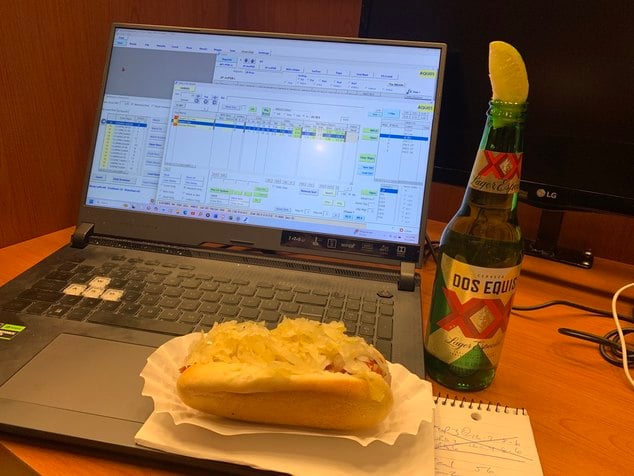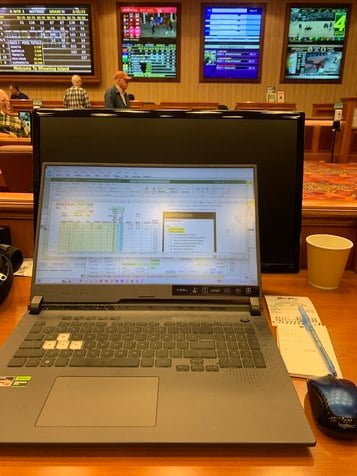Comments
-
Sat. Oct. 25 - How to Compete in the Age of the Whales (Video is up)Link for the spreadsheet.
https://www.dropbox.com/scl/fi/za59zf3pvy1frkdwwwcmw/5-Column-Model-release-10-..xlsm?rlkey=ek2aewc0dz6nzd13xq6cswzxn&st=mlv72n1m&dl=0
Couldn't do 13 columns - the calculations got WAY too intensive.
Anyone without a super-fast machine would be frustrated.
Sorry. -
Why Vegas is Losing CustomersNo more live dealers at the Golden Gate??
https://www.dropbox.com/scl/fi/ebinx7oh4sfsa53gukfn5/No-live-dealers-at-the-Golden-Gate.jpg?rlkey=7s5emx89n0dnh3lnehm5okktf&st=ynwo6e1l&dl=0 -
Why Vegas is Losing CustomersNot sure where in Las Vegas this is, but WHOA!!!!
$13.80 to $24.00 for a Slice??

-
Why Vegas is Losing CustomersReported today = 200 housekeepers laid off at the Cosmopolitan.
Weekday traffic down 33%.
Preliminary numbers show wagered dollars down 15% YOY.
Are you planning a trip?
OR
What is your alternative?
Like the old Pete Seeger song =
"Where have all the bettors gone, long time passing." -
Why Vegas is Losing Customers4-Zero Roulette? You've got to be kidding me!!
https://vegasadvantage.com/quadruple-zero-roulette-debuts-on-the-las-vegas-strip/ -
Why Vegas is Losing CustomersThis is why Vegas tourism will stay down
American shows that in his Vegas hotel you can’t even use the mini fridge anymore. They have equipped it with sensors and if you put anything inside you’ll be charged $50 per day
https://x.com/wallstreetapes/status/1956346546620080564?s=51 -
Is there a Factor for "HEART"Bruno has a followup.
Heart connotes greatness. So, how is it defined and how to we
treat those who show it?
Writer: Bruno@Racingwithbruno
Bruno@Racingwithbruno
3 days ago
4 min read
"Ah… Hans Gruber. A name forever etched into cinematic infamy. The mastermind behind the Nakatomi Plaza attack—Christmas, 1988. A man of culture, intellect, precision. And like all great villains, cloaked his greed in the illusion of purpose. “Political demands,” he said. Ideology. Justice. When in truth, it was a heist. A masterstroke of manipulation, executed beneath the banner of misdirection.
But of course, he would have gotten away with it, were it not for the uninvited guest—the barefoot cowboy with a badge, John McClane. Off-duty. Outgunned. Outnumbered. But not outmatched. One man, armed with grit and good instincts, peeled back the layers of that façade and exposed what it truly was: not rebellion, but theft. Not cause, but cover.
Now, forgive the detour down memory lane, but it brings me, rather conveniently, to the Preakness Stakes.
You see, we’ve witnessed a similar brand of theater. A carefully crafted act—this time, not with explosives and hostages, but with hypocrisy. The race runs, the winner is crowned, and suddenly the air is thick with outrage, confusion, self-righteous calls for reform. Not because the sport needs it—but because the narrative does. And just like Gruber, they wrap their heist in noble packaging.
“Think of the horses,” they say. “This is about fairness,” they insist. No. It’s about control. It’s about influence. It’s about rewriting the rules after the fact because the outcome didn't suit the agenda. A heist, plain and simple—only this one’s not about bearer bonds. It’s about the integrity of competition.
They talk of spacing the Triple Crown, of protecting the breed, of evolving the sport—but what they really want is to reshape it in their image. They want the pageantry without the pressure, the spectacle without the stakes.
Well… I’m sorry, but greatness doesn't stretch to accommodate mediocrity. And real competitors don’t ask for the rules to change after they lose.
So, yes—Hans Gruber and the post-Preakness pundits share something in common: both engineered a lie disguised as righteousness. Both underestimated the ones who could see through it.
And both—if there’s any justice left—will be met not with applause, but with a slow clap and a locked vault.
Because what we witnessed at Pimlico wasn’t just a horse race—it was a cinematic climax, a third-act twist, an explosion of grit and guts wrapped in the silks of Journalism, a colt whose name now echoes like gunfire in the stairwells of racing history.
No one was thrown from a 30th-floor window. No machine guns emerged from the smoke and rubble. But make no mistake—there were fireworks. And the post-race fallout? Oh, it's been louder than a detonator on Christmas Eve.
Fines. Suspensions. Social media hysteria. The usual suspects. People calling for Flavien Prat’s head on a pike, blaming Rispoli for everything from the contact to the curvature of the rail. “He should’ve never been inside!” they cry, from the safety of their WiFi-enabled rocking chairs, as if Umberto was playing hopscotch instead of navigating a three-horse meat grinder at 40 miles per hour.
These critics—these self-appointed stewards of truth—are the Dwayne T. Robinsons of racing. Loud. Wrong. Unflinchingly confident in their complete misunderstanding of the moment. Deputy Chief of Dumb Opinions, if you will. They don't know dipshit from apple butter, but by God, they're going to tell you all about it… emphatically, in all caps, with gifs.
But here's the inconvenient truth no one wants to admit:
Rispoli was exactly where he needed to be.
Trapped on the rail, with Flavien Prat literally in his lap—boxed in, locked down. He had two choices: get out or go down. That’s it. No third option. No magic portal opening in the stretch. And so he moved. To save the race. To save the horse. And yes, maybe to save himself from a national catastrophe on live television.
Swinging wide? That would’ve been waving the white flag. He doesn't win from the parking lot. Journalism—a beast with fire in his eyes and something to say. And say it he did.
Shoulder to shoulder with Goal Oriented, Journalism shoved his way out like a champion, as if to growl, “Get off me,” though I'm sure the language in his head was a touch more… colorful. That wasn't reckless. That wasn’t luck. That was a horse refusing to lose.
And what did it take? Heart. Guts. And the kind of bond between horse and rider that can’t be taught in a classroom or a comment thread and especially from a lounge chair in your living room.
Let’s also not pretend this win was some fluke. Did you know that Irad Ortiz Jr., as celebrated and supremely talented as he is, has never won the Kentucky Derby or the Preakness? His two Triple Crown wins came in the Belmont Stakes alone. His brother Jose? A Preakness win with Early Voting, a Belmont as well—but both brothers? Still blanked at Churchill Downs.
And now? Umberto Rispoli—unheralded, underappreciated—has done what Irad hasn't: won one of the first two legs of the Triple Crown.
But instead of celebrating that—instead of elevating the moment—we're nitpicking, second-guessing, and dissecting with the surgical precision of a barroom surgeon.
Why? Because that’s what we do to greatness in this sport. We demand it. And then, the moment it arrives? We try to tear it down.
But here's what you need to remember:
Journalism exposed both sides of the story.
The critics. The doubters. The glory. The grit. At the final running of the Preakness at old Pimlico—a place dripping in legacy—we witnessed a champion refuse to fold. He overcame. He conquered. And whether you're a believer or a cynic, you're going to remember his name.
Because this—this was not just a race. It was Die Hard on dirt.
And Journalism? Ah… yes. Journalism was John McClane—barefoot, bloodied, and bellowing “Yippee-ki-yay, mo-f@@r."
Why do we do it?? Is it human nature? Jealousy? Not sure!! -
Ky Derby winners last raceFrom Twitter:
How do we overcome this???
Mayhemily
@EmilyOptixEQ
21m
the number of horses (16) in this #kyderby field (21) with gate issues in one of their past 3 runlines is unique and compared to previous years, which is extremely high. -
What is a "Feed Bag Race"??Really?
Are we that close to having horse racing go away that that is
the best we can do on a purse?? -
It's Vegas, baby!!When it's all favorites or horses you wouldn't bet
with someone else's money:
The best $1.50 lunch in Laas Vegas:

A "free" beer in the racebook and a premium hot dog
with onions, relish and sauerkraut!!
Wish you were here!! -
It's Vegas, baby!!Bottom Line =
DO NOT depend on sitting there and doing
races as they come up. They come too fast
and too hard!!
Know which races you are going to bet
AND how many horses in each depending
on Field Size and Chaos Level and FTS
and number of Lightly Raced horses. You
must have these mapped out in advance.
The main TV screen changes from your race
immediately after the race is finished. You will
have a difficult time getting final odds if you won
if you don't use the tote function in Determinator
or write down the odds on your horses during the
running of the race.
Today was an education!! Lots of winners were
predicted by Determinator and I would have been
EXTREMELY profitable instead of just profitable
if I followed my betting rules.
I was the problem!!! -
It's Vegas, baby!!No for me on tomorrow.
The Ram is. He has 3 entries in the Last Chance
Tournament that is tomorrow. He's trying to win
another entry to go with the 1 he already has for
the BIG ONE.
Heading down to see him later in the afternoon.
He'll be at Bally's fighting the good fight for us!! -
It's Vegas, baby!!Organize - Execute!!
So much different than sitting at home with 2 monitors
and a huge desk.

ponyplayer

Start FollowingSend a Message





